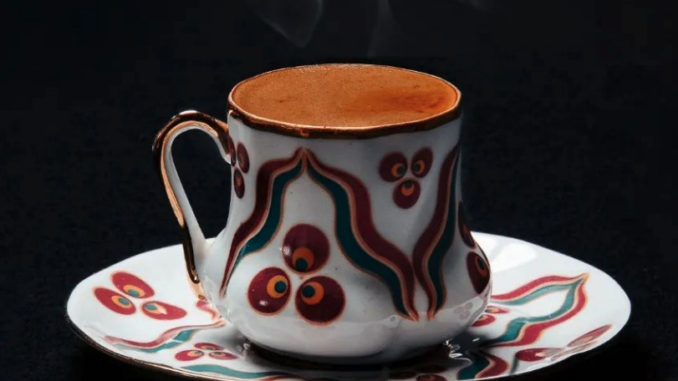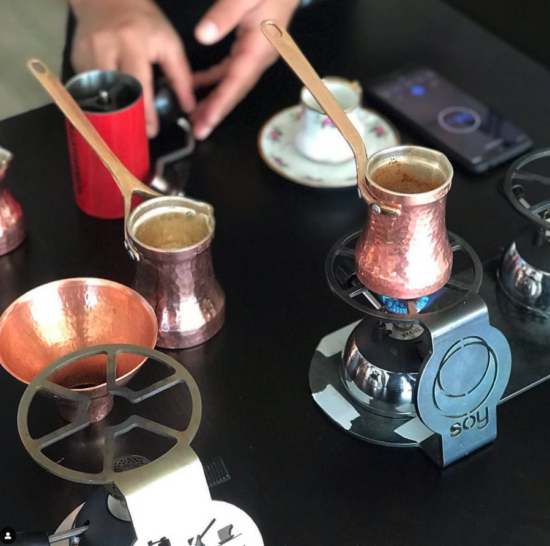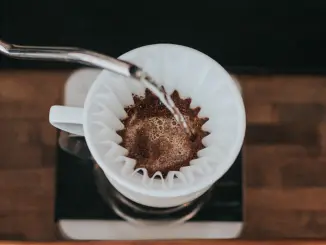
This series is dedicated to the ibrik, a traditional brewing method that is catching the eye of the specialty-coffee community—and for good reason.
BY VASILEIA FANARIOTI
SPECIAL TO BARISTA MAGAZINE ONLINE
Cover photo courtesy of Atilla Narin
The ibrik is an often underrated coffee-brewing method that is seeing a resurgence in the specialty-coffee world. This simple, centuries-old brewing device can actually produce some of the most complex and nuanced cups of coffee imaginable.
To find out how this device stacks up in the specialty-coffee world, we spoke to 2020 Italian Ibrik Champion Niki Di Landa; Specialty Turkish Coffee founder Turgay Yildizli; and Atilla Narin, general coordinator of Turkey’s first coffee museum.
Enhancing the Ibrik Design
With an interest in the ibrik brewing method on the rise, there has been a focus on modifying and enhancing the design of the traditional ibrik for a good few years now. Companies like Specialty Turkish Coffee, Soy, and El Greko have taken the classic design and made a few adjustments, such as an improved double spout and an ergonomic heat-resistant handle.
Other accessories, like functional brewing stands, sand, and gas burners, have also been designed and used by professionals to make the brewing process easier, more efficient, and more enjoyable.
Presence in SCA Exhibitions and Competitions
Since 2009, the ibrik has been a regular feature in SCA-organized competitions and exhibitions. Turgay of Specialty Turkish Coffee (STC) has attended these events both as a competitor and exhibitor of the STC Pot.
“We have been exhibiting our products since 2016 at coffee expos and festivals,” says Turgay. “It gives us the opportunity to show café and coffee shop owners that with the right equipment and workflow, this brew method can be easily added to a menu, and consistent results can be achieved in the same amount of time or less than it takes to brew with many other methods.”
Additionally, the World Cezve/Ibrik Championship (WCIC) has been held almost annually since 2009, and has undergone a few rule changes over the years to allow for more creativity while maintaining speciality standards.
The Art of Specialty Ibrik Preparation
Applying specialty-coffee standards to a traditional brewing method such as the ibrik requires understanding how to control all of the extraction variables. Ibrik competitor Niki believes that using high-quality coffee is what makes the method perform its best.
”You definitely cannot choose poor-quality raw materials, otherwise you will get a bitter aftertaste and unpleasant flavors will develop as the coffee is cooling down,” Niki advises. “Ibrik has its own brew ratio; some waters are more suitable than others; heat and brew time play a great role in the perfect extraction.”
Roasting and grinding for this device also need to be taken into consideration. Coffee ground for ibrik should have the consistency of flour, which means it’s very finely ground. Developing a roast profile that can withstand the immersion variables and high temperatures, while still extracting all the desirable flavors, requires skill and a close understanding of the roast process.
A New Sensory Experience
While the world of specialty coffee is taking notice of the ibrik, it is those who have been drinking this style of coffee for years that will be a tougher audience to crack. Most nations that enjoy ibrik coffee have developed a palate for its more traditional flavor profiles, usually characterized by smokiness and seasoned with sugar and spices.
Atilla sees this as an opportunity to educate coffee lovers about ibrik’s versatility. The newly opened Safranbolu Coffee Museum, Turkey’s very first coffee museum, serves 14 different ibrik coffees on its menu. Guests can also try Atilla’s signature drink from the 2019 CIC competition: a mix of coffee, cranberry sorbet, almond milk, and coconut sugar.
“There are many ways to get creative with an ibrik and craft various drinks. Our menu of 14 different ibrik coffees is the proof,” says Atilla. “Every year, 200,000 visitors try these drinks and they love them. If coffee shops get a bit more creative, they will recognize the versatility of this brewing method.”

The ibrik is a brewing method with a long and rich history. While it has been around for ages, its recent rise in the specialty-coffee world has brought it newfound popularity. As more people learn about the ibrik and its potential, we think it’s safe to say that this brewing method is here to stay.
ABOUT THE AUTHOR
Vasileia Fanarioti (she/her) is a freelance copywriter and editor with a primary focus on the coffee niche. She has also been a volunteer copywriter for the I’M NOT A BARISTA NPO, providing content to help educate people about baristas and their work. You can follow her adventures at thewanderingbean.net.




